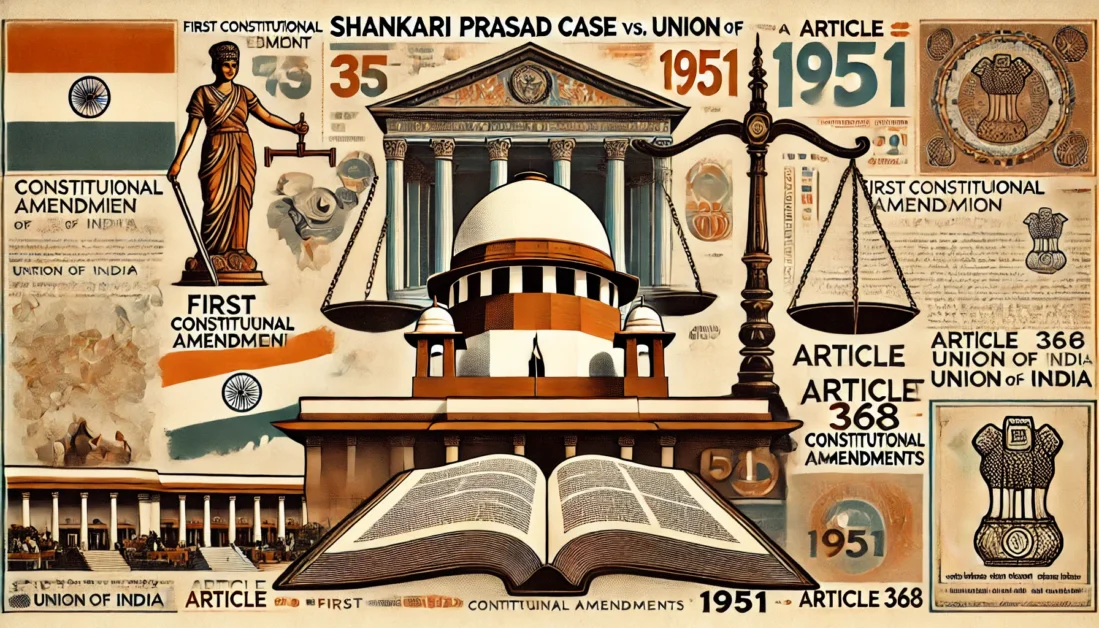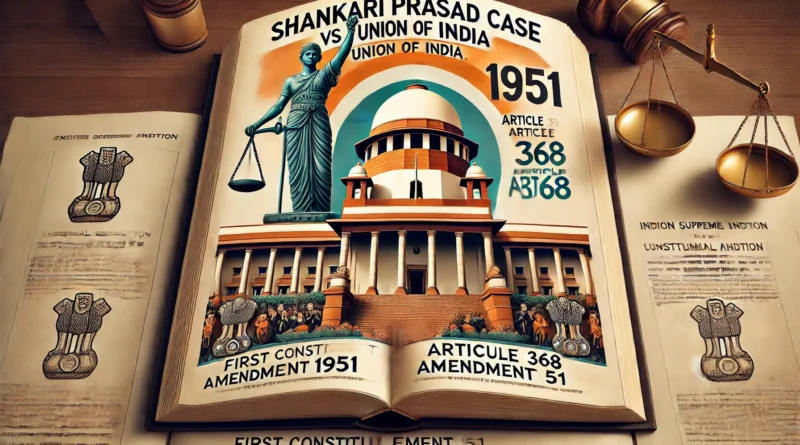Shankari Prasad Case vs. Union of India (1951)
The Shankari Prasad Case vs Union of India (1951) is a landmark constitutional case that revolved around the First Constitutional Amendment (1951) and its impact on fundamental rights in India. This case challenged the government’s power to amend Article 31, which dealt with the right to property, under the Constitution.
The Supreme Court’s judgment had profound implications for the power of Parliament to alter fundamental rights and amend the Indian Constitution.
Table of Contents
Background of the Shankari Prasad Case
In the early years after independence, India struggled with poverty and needed socio-economic reforms, especially in the agricultural sector. The Bihar Land Reforms Act (1950), introduced to redistribute land to the landless, was challenged by landlords because it violated their fundamental right to property under Article 31.
Patna High Court Judgment
The Patna High Court ruled in favor of the landlords, declaring the Bihar Land Reforms Act unconstitutional. To override this judgment, the Indian government introduced the First Constitutional Amendment (1951), which inserted Articles 31A and 31B, protecting certain land reform laws from judicial review. This led to the filing of the Shankari Prasad case before the Supreme Court.
Key Legal Issues in the Shankari Prasad Case
The case raised critical constitutional questions, including:
- Can Parliament Amend Fundamental Rights?
- What is the Scope of Parliament’s Power under Article 368?
- Does the First Constitutional Amendment Violate Article 13(2)?
These questions were crucial because they dealt with the balance of power between the legislature and the judiciary, especially concerning fundamental rights and constitutional amendments.

Supreme Court’s Decision in Shankari Prasad Case
The Supreme Court addressed the conflict between Article 13(2), which restricts the power of the state to infringe on fundamental rights, and Article 368, which provides Parliament the power to amend the Constitution. The Court applied the doctrine of harmonious construction to resolve the conflict, ruling that the term “law” in Article 13(2) referred to ordinary laws, not constitutional amendments.
Therefore, the Supreme Court upheld the First Constitutional Amendment (1951) and concluded that Parliament had the power to amend fundamental rights under Article 368, including the right to property under Article 31.
Why is the Shankari Prasad Case Important?
The judgment clarified the extent of Parliamentary power to amend the Indian Constitution, particularly the fundamental rights. It confirmed that Parliament could amend fundamental rights, as long as it followed the procedure outlined in Article 368. The Court upheld Articles 31A and 31B, which shielded certain land reform laws from judicial scrutiny, even if they affected the right to property.
However, this also raised concerns about the potential abuse of power by Parliament, as it could alter fundamental rights at its discretion.
Criticisms and Concerns of the Judgment
Several criticisms were leveled against the judgment:
- Limited Scope of Article 13(2): Critics argued that the Court’s interpretation of Article 13(2) was too narrow. The provision should have protected not just ordinary laws but also constitutional amendments that affected fundamental rights.
- Excessive Power to Parliament: The ruling gave Parliament nearly unlimited power to amend the Constitution, which could potentially weaken or even abolish fundamental rights. This raised concerns about the balance of power between the legislature and judiciary.
Key Takeaways
- Shankari Prasad challenged the First Constitutional Amendment (1951) that protected agrarian land reforms from judicial review.
- The Supreme Court ruled that Parliament could amend fundamental rights under Article 368.
- Articles 31A and 31B were validated, protecting specific land reform laws from judicial scrutiny.
- The judgment raised concerns about the abuse of Parliamentary power and the future of fundamental rights, which was later addressed in the Kesavananda Bharati case through the Basic Structure Doctrine.
The Shankari Prasad Case confirmed that Parliament could change fundamental rights under Article 368. However, this raised concerns about giving too much power to the government. Later, in the Kesavananda Bharati case (1973), the Supreme Court introduced the idea of the Basic Structure Doctrine.
Further, the Court ruled that while Parliament can amend the Constitution, it cannot change its basic structure, which includes protecting fundamental rights. This doctrine was created to prevent Parliament from misusing its power, addressing the issues left by the Shankari Prasad decision.

